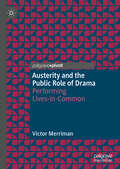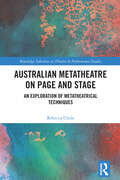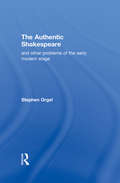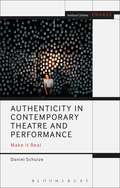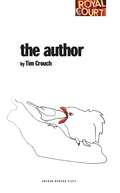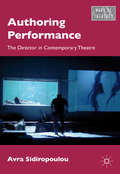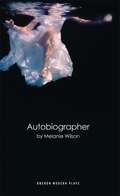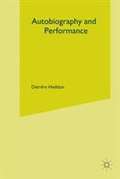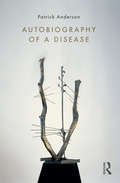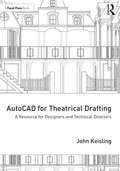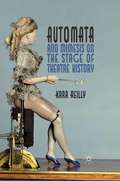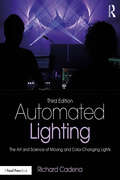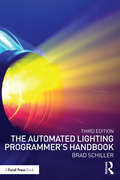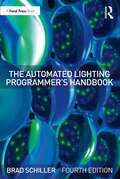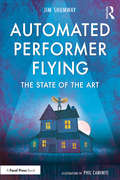- Table View
- List View
Austerity and the Public Role of Drama: Performing Lives-in-Common
by Victor MerrimanThis book asks what, if any, public role drama might play under Project Austerity – an intensification phase of contemporary liberal political economy. It investigates the erosion of public life in liberal democracies, and critiques the attention economy of deficit culture, by which austerity erodes life-in-common in favour of narcissistic performances of life-in-public. It argues for a social order committed to human flourishing and deliberative democracy, as a counterweight to the political economy of austerity. It demonstrates, using examples from England, Ireland, Italy, and the USA, that drama and the academy pursue shared humane concerns; the one, a critical art form, the other, a social enabler of critical thought and progressive ideas. A need for dialogue with emergent forms of collective consciousness, new democratic practices and institutions, shapes a manifesto for critical performance, which invites universities and cultural workers to join other social actors in imagining and enabling ethical lives-in-common.
Australian Metatheatre on Page and Stage: An Exploration of Metatheatrical Techniques (Routledge Advances in Theatre & Performance Studies)
by Rebecca ClodeThis book offers the first major discussion of metatheatre in Australian drama of the late twentieth and early twenty-first centuries. It highlights metatheatre’s capacity to illuminate the wider social, cultural, and artistic contexts in which plays have been produced. Drawing from existing scholarly arguments about the value of considering metatheatre holistically, this book deploys a range of critical approaches, combining textual and production analysis, archival research, interviews, and reflections gained from observing rehearsals. Focusing on four plays and their Australian productions, the book uses these examples to showcase how metatheatre has been utilised to generate powerful elements of critique, particularly of Indigenous/non-Indigenous relations. It highlights metatheatre’s vital place in Australian dramatic and theatrical history and connects this Australian tradition to wider concepts in the development of contemporary theatre. This illuminating text will be of interest to students and scholars of Australian theatre (historic and contemporary) as well as those researching and studying drama and theatre studies more broadly.
Australian Metatheatre on Page and Stage: An Exploration of Metatheatrical Techniques (Routledge Advances in Theatre & Performance Studies)
by Rebecca ClodeThis book offers the first major discussion of metatheatre in Australian drama of the late twentieth and early twenty-first centuries. It highlights metatheatre’s capacity to illuminate the wider social, cultural, and artistic contexts in which plays have been produced. Drawing from existing scholarly arguments about the value of considering metatheatre holistically, this book deploys a range of critical approaches, combining textual and production analysis, archival research, interviews, and reflections gained from observing rehearsals. Focusing on four plays and their Australian productions, the book uses these examples to showcase how metatheatre has been utilised to generate powerful elements of critique, particularly of Indigenous/non-Indigenous relations. It highlights metatheatre’s vital place in Australian dramatic and theatrical history and connects this Australian tradition to wider concepts in the development of contemporary theatre. This illuminating text will be of interest to students and scholars of Australian theatre (historic and contemporary) as well as those researching and studying drama and theatre studies more broadly.
Authentic Movement: Essays by Mary Starks Whitehouse, Janet Adler and Joan Chodorow
by Joan Chodorow Zoe Arlene Avstreih Suzanne Lovell Lisa Tsetse Andrea J. Olsen Heidi J. Ehrenreich Margareta Neuberger Daphne A. Lowell Barbara Holifield Cassielle Alaya Bull Antonella Adorisio Sox Sperry Tina Stromsted Neala Haze Wendy Goulston Shira Musicant Janet Adler Judith Koltai Jan Sandman Julie Joslyn Brown Ariane Goodwin Soraia Jorge Marcia Plevin Alton Wasson David Mars Sandy Dibbell-Hope Lynn Garland Susan Frieder Anne Hebert Smith Carol Fields Susan Bauer Bill McCully Wendy McGinty-WymanAuthentic Movement, an exploration of the unconscious through movement, was largely defined by the work of Mary Starks Whitehouse, Janet Adler and Joan Chodorow. The basic concepts of Authentic Movement are expressed for the first time in one volume through interviews and conversations with these important figures, and their key papers.
The Authentic Shakespeare: and Other Problems of the Early Modern Stage
by Stephen OrgelFirst published in 2003. Routledge is an imprint of Taylor & Francis, an informa company.
The Authentic Shakespeare: and Other Problems of the Early Modern Stage
by Stephen OrgelFirst published in 2003. Routledge is an imprint of Taylor & Francis, an informa company.
Authenticity in Contemporary Theatre and Performance: Make it Real (Methuen Drama Engage)
by Daniel Schulze Enoch Brater Mark Taylor-BattyAuthenticity is one of the major values of our time. It is visible everywhere, from clothing to food to self-help books. While it is such a prevalent phenomenon, it is also very evasive. This study analyses the 'culture of authenticity' as it relates to theatre and establishes a theoretical framework for analysis. Daniel Schulz argues that authenticity is sought out and marked by the individual and springs from a culture that is perceived as inherently fake and lacking depth. The study examines three types of performances that exemplify this structure of feeling: intimate theatre seen in Forced Entertainment productions such as Quizoola! (1996, 2015), as well as one-on-one performances, such as Oentroerend Goed's Internal (2009); immersive theatres as illustrated by Punchdrunk's shows The Masque of the Red Death (2007) and The Drowned Man (2013) which provide a visceral, sensate understanding for audiences; finally, the study scrutinises the popular category of documentary theatre through various examples such as Robin Soan's Talking to Terrorists (2005), David Hare's Stuff Happens (2004), Edmund Burke's Black Watch (2007) and Dennis Kelly's pseudo-documentary play Taking Care of Baby (2007). It is specifically the value of the document that lends such performances their truth-value and consequently their authenticity. The study analyses how the success of these disparate categories of performance can be explained through a common concern with notions of truth and authenticity. It argues that this hunger for authentic, unmediated experience is characteristic of a structure of feeling that has superseded postmodernism and that actively seeks to resignify artistic and cultural practices of the everyday.
Authenticity in Contemporary Theatre and Performance: Make it Real (Methuen Drama Engage)
by Daniel Schulze Prof. Enoch Brater Mark Taylor-BattyAuthenticity is one of the major values of our time. It is visible everywhere, from clothing to food to self-help books. While it is such a prevalent phenomenon, it is also very evasive. This study analyses the 'culture of authenticity' as it relates to theatre and establishes a theoretical framework for analysis. Daniel Schulz argues that authenticity is sought out and marked by the individual and springs from a culture that is perceived as inherently fake and lacking depth. The study examines three types of performances that exemplify this structure of feeling: intimate theatre seen in Forced Entertainment productions such as Quizoola! (1996, 2015), as well as one-on-one performances, such as Oentroerend Goed's Internal (2009); immersive theatres as illustrated by Punchdrunk's shows The Masque of the Red Death (2007) and The Drowned Man (2013) which provide a visceral, sensate understanding for audiences; finally, the study scrutinises the popular category of documentary theatre through various examples such as Robin Soan's Talking to Terrorists (2005), David Hare's Stuff Happens (2004), Edmund Burke's Black Watch (2007) and Dennis Kelly's pseudo-documentary play Taking Care of Baby (2007). It is specifically the value of the document that lends such performances their truth-value and consequently their authenticity. The study analyses how the success of these disparate categories of performance can be explained through a common concern with notions of truth and authenticity. It argues that this hunger for authentic, unmediated experience is characteristic of a structure of feeling that has superseded postmodernism and that actively seeks to resignify artistic and cultural practices of the everyday.
The Author (Oberon Modern Plays)
by Tim CrouchWinner of the 2010 Whiting Award for best new play.Winner of the 2010 Total Theatre Award for Innovation.Nominated in the Evening Standard Theatre Awards 2010.Settle back into the warmth of the theatre. Relax as the story unfolds. For you. With you. Of you. A story of hope, violence and exploitation. Laugh with the actors, tap your feet to the music, turn to your neighbour. You’re here.The Author tells the story of another play: a violent, shocking and abusive play written by a playwright called Tim Crouch and performed at the Royal Court Theatre. It charts the effect that play had on the two actors who acted in it and an audience member who watched it. The Author explores our responsibilities to what we choose to look at in the world and how we choose to act accordingly. Performed within its audience, it is a brilliantly inventive and theatrical study of what we deem acceptable in the name of Art.‘A bold, brave, playful piece, a devastating riff on ways of seeing and turning a blind eye to our own moral choices 4 stars… a dazzling theatrical experience that lets nobody off the hook’ - Lyn Gardner, The Guardian‘At once sharply satirical and coolly thought-provoking. 4 stars’ - Dominic Cavendish, The Telegraph‘The Author is by turns funny, twee, exciting, unnerving and dull, and I don’t think I’ll ever forget it.’ The Times ‘The writing is subtly brilliant, the sense of moral responsibility and exploration even greater. And because of its unusual form, it doesn’t let the audience off the hook either.’ The Scotsman
Authoring Performance: The Director in Contemporary Theatre (What is Theatre?)
by A. SidiropoulouA historical, theoretical, and comparative study of the emergence of the director-as-author phenomenon, posing questions of authorship and redefining the relationship between 'playwright' and the director-playwright.
Autobiographer (Oberon Modern Plays)
by Melanie WilsonCombining a lyrical text, immersive staging and an enigmatic and compelling performance style, Autobiographer draws us into the unravelling mind of its central character, Flora. Voiced by multiple performers, Flora reveals a curious and evocative portrait of a life refracted through the lens of dementia, layered from fragments of stories and pulses of memory. This tender, poetic and thrilling performance features a cast of four and a bold and electrifying score of voice and sound.'Autobiographer successfully presents us with one reality of dementia and our attitudes to it… deeply poetical' – Exeunt Magazine 'Wilson uses an unobtrusive vocabulary to say something quietly surprising. It is the beauty of telling stories, even when there is no narrative. And it is the importance of people connecting, especially if we don’t know who we are' 4 stars - Spoonfed 'This show is a long poem, shakily and delicately sketched in our minds by four women, who in similar clothing represent the life of one woman… A clear amount of loving research has gone into this work, which considers the terrible nature of dementia without making it overly sentimental' 4 stars – The Public Reviews ‘Heartfelt and lyrical’ – Guardian ‘Autobiographer is a work of vivid poetry’ –Time Out London
Autobiography and Performance (Theatre And Performance Practices Ser.)
by Deirdre HeddonOffering a comprehensive overview of the use of autobiography in performance, this title uncovers the political potentials and limits that accompany the use of the personal in performance.
Autobiography of a Disease (Writing Lives: Ethnographic Narratives)
by Patrick AndersonAutobiography of a Disease documents, in experimental form, the experience of extended life-threatening illness in contemporary US hospitals and clinics. The narrative is based primarily on the author’s sudden and catastrophic collapse into a coma and long hospitalization thirteen years ago; but it has also been crafted from twelve years of research on the history of microbiology, literary representations of illness and medical treatment, cultural analysis of MRSA in the popular press, and extended autoethnographic work on medicalization. An experiment in form, the book blends the genres of storytelling, historiography, ethnography, and memoir. Unlike most medical memoirs, told from the perspective of the human patient, Autobiography of a Disease is told from the perspective of a bacterial cluster. This orientation is intended to represent the distribution of perspectives on illness, disability, and pain across subjective centers—from patient to monitoring machine, from body to cell, from caregiver to cared-for—and thus makes sense of illness only in a social context.
Autobiography of a Disease (Writing Lives: Ethnographic Narratives)
by Patrick AndersonAutobiography of a Disease documents, in experimental form, the experience of extended life-threatening illness in contemporary US hospitals and clinics. The narrative is based primarily on the author’s sudden and catastrophic collapse into a coma and long hospitalization thirteen years ago; but it has also been crafted from twelve years of research on the history of microbiology, literary representations of illness and medical treatment, cultural analysis of MRSA in the popular press, and extended autoethnographic work on medicalization. An experiment in form, the book blends the genres of storytelling, historiography, ethnography, and memoir. Unlike most medical memoirs, told from the perspective of the human patient, Autobiography of a Disease is told from the perspective of a bacterial cluster. This orientation is intended to represent the distribution of perspectives on illness, disability, and pain across subjective centers—from patient to monitoring machine, from body to cell, from caregiver to cared-for—and thus makes sense of illness only in a social context.
AutoCAD for Theatrical Drafting: A Resource for Designers and Technical Directors
by John KeislingAutoCAD for Theatrical Drafting provides an introduction to the software AutoCAD, specifically focusing on how to navigate the commands most commonly used when creating design, construction and installation drafting plates for theatrical use. Beginning with a step-by-step tutorial of how to download the program and a review of theatrical drafting standards, the text details commands used in 2D drafting and 3D modeling and how to create theatrical drafting plates using AutoCAD that meet those drafting standards. It also provides guidance on how to transition from 2D drafting to 3D modeling, how to use 3D models to create camera views and animations and how to use 3D models for production and engineering purposes. Intended as a resource for the beginning and intermediate AutoCAD user, AutoCAD for Theatrical Drafting provides easy-to-follow instructions that readers can refer to while using the AutoCAD software.
AutoCAD for Theatrical Drafting: A Resource for Designers and Technical Directors
by John KeislingAutoCAD for Theatrical Drafting provides an introduction to the software AutoCAD, specifically focusing on how to navigate the commands most commonly used when creating design, construction and installation drafting plates for theatrical use. Beginning with a step-by-step tutorial of how to download the program and a review of theatrical drafting standards, the text details commands used in 2D drafting and 3D modeling and how to create theatrical drafting plates using AutoCAD that meet those drafting standards. It also provides guidance on how to transition from 2D drafting to 3D modeling, how to use 3D models to create camera views and animations and how to use 3D models for production and engineering purposes. Intended as a resource for the beginning and intermediate AutoCAD user, AutoCAD for Theatrical Drafting provides easy-to-follow instructions that readers can refer to while using the AutoCAD software.
Automata and Mimesis on the Stage of Theatre History
by K. ReillyThe automaton, known today as the robot, can be seen as a metaphor for the historical period in which it is explored. Chapters include examinations of Iconoclasm's fear that art might surpass nature, the Cartesian mind/body divide, automata as objects of courtly desire, the uncanny Olympia, and the revolutionary Robots in post-WWI drama.
Automated Lighting: The Art and Science of Moving and Color-Changing Lights
by Richard CadenaAutomated Lighting: The Art and Science of Moving and Color-Changing Lights, Third Edition (formerly Automated Lighting: The Art and Science of Moving Light) continues to be the most trusted text for working and aspiring lighting professionals. Now in its third edition, it has been fully updated to reflect the vast changes in stage and studio luminairies—including LEDs, switch-mode power supplies, optics, networking, Ethernet-based protocols like Art-Net and sACN, wireless DMX, and much more. Its written in clear, easy-to-understand language and includes enough detailed information to benefit for the most experienced technicians, programmers, and designers. Additional content and resources are provided at the author's website www.automatedlighting.pro.
Automated Lighting: The Art and Science of Moving and Color-Changing Lights
by Richard CadenaAutomated Lighting: The Art and Science of Moving and Color-Changing Lights, Third Edition (formerly Automated Lighting: The Art and Science of Moving Light) continues to be the most trusted text for working and aspiring lighting professionals. Now in its third edition, it has been fully updated to reflect the vast changes in stage and studio luminairies—including LEDs, switch-mode power supplies, optics, networking, Ethernet-based protocols like Art-Net and sACN, wireless DMX, and much more. Its written in clear, easy-to-understand language and includes enough detailed information to benefit for the most experienced technicians, programmers, and designers. Additional content and resources are provided at the author's website www.automatedlighting.pro.
The Automated Lighting Programmer's Handbook
by Brad SchillerThis guide helps lighting designers with the creative and operational challenges they face in their rapidly evolving industry. Providing respected and clear coverage of the process of programming automated lighting fixtures, the author brings the designer from basic principles to preproduction preparations. Concepts, procedures, and guidelines to ensure a successful production are covered as well as troubleshooting, much needed information on work relationships, and technology including LED lighting, console networking, digital lighting, and more. Chapters are peppered with advice and war stories from some of the most prominent lighting designers of today.
The Automated Lighting Programmer's Handbook
by Brad SchillerThis guide helps lighting designers with the creative and operational challenges they face in their rapidly evolving industry. Providing respected and clear coverage of the process of programming automated lighting fixtures, the author brings the designer from basic principles to preproduction preparations. Concepts, procedures, and guidelines to ensure a successful production are covered as well as troubleshooting, much needed information on work relationships, and technology including LED lighting, console networking, digital lighting, and more. Chapters are peppered with advice and war stories from some of the most prominent lighting designers of today.
The Automated Lighting Programmer's Handbook
by Brad SchillerThe Automated Lighting Programmer’s Handbook, fourth edition, provides respected and clear coverage of the process of programming automated lighting fixtures from basic principles to advanced production preparations. This guide helps lighting programmers and designers with the creative and operational challenges they face in their rapidly evolving industry. Concepts, procedures, and guidelines to ensure a successful production are covered as well as troubleshooting, much needed information on workflows, technology, work relationships, console networking, digital lighting, and more. Chapters are peppered with advice and war stories from some of the most prominent lighting designers and programmers of today. The fourth edition is the most comprehensive yet: added topics include programming structure, advanced recording/editing, cloning, multi-cell fixtures, safety routines, GDTF, and pre-visualization. Deep explorations into the work of programmers from Earlybird and Broadway provide readers with timely real-world scenarios and advice. The information in this book is perfect for anyone interested in the programming of automated lighting in any market. From the beginner to the expert, the methodologies within provide simple, yet powerful tools to assist with any production. Lighting designers also will gain important knowledge about the procedures and concepts utilized by lighting programmers.
The Automated Lighting Programmer's Handbook
by Brad SchillerThe Automated Lighting Programmer’s Handbook, fourth edition, provides respected and clear coverage of the process of programming automated lighting fixtures from basic principles to advanced production preparations. This guide helps lighting programmers and designers with the creative and operational challenges they face in their rapidly evolving industry. Concepts, procedures, and guidelines to ensure a successful production are covered as well as troubleshooting, much needed information on workflows, technology, work relationships, console networking, digital lighting, and more. Chapters are peppered with advice and war stories from some of the most prominent lighting designers and programmers of today. The fourth edition is the most comprehensive yet: added topics include programming structure, advanced recording/editing, cloning, multi-cell fixtures, safety routines, GDTF, and pre-visualization. Deep explorations into the work of programmers from Earlybird and Broadway provide readers with timely real-world scenarios and advice. The information in this book is perfect for anyone interested in the programming of automated lighting in any market. From the beginner to the expert, the methodologies within provide simple, yet powerful tools to assist with any production. Lighting designers also will gain important knowledge about the procedures and concepts utilized by lighting programmers.
Automated Performer Flying: The State of the Art
by Jim ShumwayAutomated Performer Flying: The State of the Art shares the secrets of performer flying in entertainment history and provides step-by-step instructions on how to create a performer flying effect from scratch. This book sheds light on all aspects of performer flying, covering its history, explaining concepts like mechanical compensation versus electrical compensation, providing guidance on how to calculate stopping distances and forces, and sharing tips on how to build successful relationships with performers. Case studies of prominent productions featuring performer flying, including Cirque du Soleil and Beyoncé, are included throughout. Written for technical directors, theatrical riggers, and students of rigging, technical direction, and stagecraft courses, Automated Performer Flying takes readers through the process of creating a performer flying effect from the first spark of the idea to opening night.
Automated Performer Flying: The State of the Art
by Jim ShumwayAutomated Performer Flying: The State of the Art shares the secrets of performer flying in entertainment history and provides step-by-step instructions on how to create a performer flying effect from scratch. This book sheds light on all aspects of performer flying, covering its history, explaining concepts like mechanical compensation versus electrical compensation, providing guidance on how to calculate stopping distances and forces, and sharing tips on how to build successful relationships with performers. Case studies of prominent productions featuring performer flying, including Cirque du Soleil and Beyoncé, are included throughout. Written for technical directors, theatrical riggers, and students of rigging, technical direction, and stagecraft courses, Automated Performer Flying takes readers through the process of creating a performer flying effect from the first spark of the idea to opening night.
